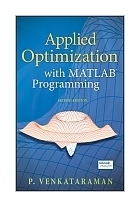|
||
• wydawnictwa polskie
• Zamów informacje o nowościach z wybranego tematu • kontakt
• Cookies na stronie |
APPLIED OPTIMIZATION WITH MATLAB PROGRAMMING 2ND EDITIONVENKATARAMAN P.wydawnictwo: WILEY , rok wydania 2009, wydanie IIcena netto: Provides all the tools needed to begin solving optimization problems using MATLAB® The Second Edition of Applied Optimization with MATLAB® Programming enables readers to harness all the features of MATLAB® to solve optimization problems using a variety of linear and nonlinear design optimization techniques. By breaking down complex mathematical concepts into simple ideas and offering plenty of easy-to-follow examples, this text is an ideal introduction to the field. Examples come from all engineering disciplines as well as science, economics, operations research, and mathematics, helping readers understand how to apply optimization techniques to solve actual problems. This Second Edition has been thoroughly revised, incorporating current optimization techniques as well as the improved MATLAB® tools. Two important new features of the text are:
Each chapter ends with a set of problems that give readers an opportunity to put their new skills into practice. Almost all of the numerical techniques covered in the text are supported by MATLAB® code, which readers can download on the text's companion Web site www.wiley.com/go/venkat2e and use to begin solving problems on their own. This text is recommended for upper-level undergraduate and graduate students in all areas of engineering as well as other disciplines that use optimization techniques to solve design problems. P. Venkataraman, PhD, is an associate professor in the Mechanical Engineering Department, Rochester Institute of Technology, Rochester, New York. Table of Contents Preface to the Second Edition. Preface. Chapter 1: Introduction. 1.1 Optimization Fundamentals. 1.2 Introduction to MATLAB. Problems. Chapter 2: Graphical Optimization. 2.1 Problem Definition. 2.2 Graphical Solution. 2.3 Additional Examples. 2.4 Additional MATLAB Graphics. References. Problems. Chapter 3: Linear Programming. 3.1 Problem Definition. 3.2 Graphical Solution. 3.3 Numerical Solution - The Simplex Method. 3.4 Additional Examples. 3.5.Additional Topics in Linear Programming. References. Problems. Chapter 4: Nonlinear Programming. 4.1 Problem Definition. 4.2 Mathematical Concepts. 4.3 Analytical Conditions. 4.4 Examples. 4.5 Additional Topics. References. Problems. Chapter 5: Numerical Techniques - The One Dimensional Problem. 5.1 Problem Definition. 5.2 Numerical Techniques. 5.3 Importance of the One Dimensional Problem. 5.4 Additional Examples. References. Problems. Chapter 6: Numerical Techniques for Unconstrained Optimization. 6.1 Problem Definition. 6.2 Numerical Techniques: Non Gradient Methods. 6.3 Numerical Technique: Gradient Based Methods. 6.4 Numerical Technique: Second Order. 6.5 Additional Examples. 6.6 Summary. References. Problems. Chapter 7: Numerical Techniques for Constrained Optimization. 7.1 Problem Definition. 7.2 Indirect Methods for Constrained Optimization. 7.3 Direct Methods for Constrained Optimization. 7.4 Additional Examples. References. Problems. Chapter 8: Discrete Optimization. 8.1 Concepts in Discrete Programming. 8.2 Discrete Optimization Techniques. 8.3 Additional Examples. References. Problems. Chapter 9: Global Optimization. 9.1 Problem Definition. 9.2 Numerical Techniques and Additional Examples. References. Problems. Chapter 10: Optimization Toolbox from MATLAB. 10.1 The Optimization Toolbox. 10.2 Examples. References. Chapter 11: Hybrid Mathematics: An Application of. 11.1 Central Idea. 11.2 Data Handling Examples. 11.3. Solutions to Differential Systems. 11.4 Summary. References. Index. 544 pages, Hardcover
Po otrzymaniu zamówienia poinformujemy, |


